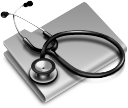Learn about Kidney Disease
Overview about Kidneys
Kidneys don’t always get the respect they deserve. Maybe, it’s because they’re relatively small. Maybe, it’s because when they’re functioning normally, we simply take them for granted. But, kidneys are truly impressive and the more you learn, the more you’ll understand why you want to help keep them healthy.
When you find out you have been diagnosed with chronic kidney disease (CKD), it can be overwhelming. Sometimes you must suddenly change a lifetime of habits. One way to maintain as good a health as possible is to learn about your kidneys.
Diabetes, high blood pressure, cardiovascular (heart or blood vessel) disease, and a family history of kidney failure are the key risk factors for chronic kidney disease. If you or a family member have any of these risk factors, it is important to learn about the basics of kidney disease and how to keep the kidneys healthier longer.
Location of your Kidneys
Kidneys are bean-shaped organs located on either side of your spine at the lowest level of your rib cage. Kidneys may be small organs, but they work hard. Each kidney is about the size of a fist and weighs between four to six ounces. The kidneys rest above a person’s waist. The left kidney is slightly higher and a little larger than the right kidney, which is located next to the liver. Both kidneys are protected by the rib cage.
Kidney Functions
The body extracts nutrients from food and beverages, and uses them to keep the body functioning properly. Approximately 200 quarts of blood are processed through your kidneys every 24 hours. The kidney’s primary function is to clean the blood by removing waste. In addition to filtering, the kidneys monitor the levels of chemicals, salts and acids in the blood. Inside the nephrons are sensors that keep track of sodium, phosphorus, calcium and potassium. When levels are high, the kidneys signal to remove the excess from your blood for elimination. On the other hand, kidneys are powerful chemical factories that perform the following functions:- Remove waste products from the body
- Remove drugs form the body
- Balance the fluid content in the body
- Produce the enzyme renin that helps regulate blood pressure
- Activate vitamin D that promotes strong, healthy bones
- Produce the hormone erythropoietin to help make red blood cells
Inside the Kidney
Each of our kidneys has about 1.0 to 1.3 million tiny filters, called nephrons if nephrons are damaged, they stop working. But if the damage continues, more and more nephrons shut down. After a certain point, the nephrons that are left cannot filter your blood well enough to keep you healthy.With each heartbeat, blood flows through the kidneys. Each kidney contains up to a million filtering units called nephrons. Each nephron is made up of tiny capillary loops called a glomerulus. Millions of glomeruli (plural of glomerulus) filter urea, other waste and excess water from the blood.
Each glomeruli attaches to the opening of a small fluid-collecting tube, called a tubule. The clean (filtered) blood returns to the blood stream, while the tubules sort out what the glomeruli filtered from the blood. The tubules save the needed substances and remove any waste.
The tubules lead to the collecting duct where urine is drained into a funnel-shaped sac called the renal pelvis. Each kidney has a ureter (a muscular duct) that connects the renal pelvis to the bladder. Urine from the kidneys flows through the ureters into the bladder and is passed out of the body through the urethra.
Diabetes and high blood pressure are the leading causes of chronic kidney disease. Some of the conditions mentioned can also happen at any age.
What you should know about kidney disease
- Early kidney disease has no signs or symptoms.
- Kidney disease usually does not go away.
- Kidney disease can be treated. The earlier you know you have it, the better.
- Blood and urine tests are used to check for kidney disease.
- Kidney disease can progress to kidney failure.
Kidney disease basics
Heart Disease and Kidney DiseaseKidney disease means that the kidneys are damaged and can't filter blood like they should. This damage can cause wastes to build up in the body. It can also cause other problems that can harm your health.
For most people, kidney damage occurs slowly over many years, often due to diabetes or high blood pressure. This is called chronic kidney disease. When someone has a sudden change in kidney function—because of illness, or injury, or have taken certain medications—this is called acute kidney injury. This can occur in a person with normal kidneys or in someone who already has kidney problems.
People with kidney disease often have high blood pressure, and are more likely to have a stroke or heart attack. They can also develop anemia (low number of red blood cells), bone disease, and malnutrition. Kidney disease can get worse over time, and may lead to kidney failure.
More than 20 million Americans may have kidney disease and many more are at risk. Anyone can develop kidney disease, regardless of age or race. The main risk factors for developing kidney disease are:
- Diabetes,
- High blood pressure,
- Cardiovascular (heart and blood vessel) disease, and
- A family history of kidney failure.
If you have any of these risk factors, get tested for kidney disease. Early kidney disease has no signs or symptoms.
- Get checked for kidney disease and learn about what you can do to keep your kidneys healthy help delay or even prevent kidney failure by treating kidney disease early.
